More so, typography is among the most important parts of graphic design. It is not just about picking some letters or some characters to lay out; it is about conveying messages through the style and the text appearance. The fonts you choose can really influence how your message is perceived, whether it’s a logo, website, poster, or any other graphic. In this blog, we will be discussing why typography is important in designing visual content or any product and how to choose the right typeface for your design project.
The Importance of Typography in Graphic Design:
Typography is more than reading at its core. It’s about how the design makes you feel. Fonts do have an associated feeling, and they establish the mood of a message even before it’s read. For example, a playful, whimsical font is probably going to convey a fun, casual vibe, while a sleek, modern typeface may exude professionalism and elegance. Typography can also help to make a design feel cohesive, balanced, visually pleasing.
Consider iconic brands such as Coca-Cola or Apple—their typefaces are part of their DNA. Typography is a visual language that tells a story, so designers have to make sure to choose fonts that match their project goals.
Understanding Font Categories
Before we get into selecting a font, we need to understand a few broad categories to which fonts belong. Each font family has unique traits that can help communicate the intended message:
- Serif Fonts: A serif font has small lines or embellishments at the end of the strokes that make up the letter. These typefaces are frequently considered classic, dependable, and formal. Examples of serif fonts are Times New Roman, Garamond, and Georgia. The same goes for print materials such as books, newspapers, and long-form content.
- Sans-Serif Fonts: Sans-Serif fonts are without the small lines at the end of the person’s own process of the letter. These are very readable fonts, and they are widely used for web design due to their readily readable formats on computer monitors. Well-known sans-serif fonts include Helvetica, Arial, and Futura.
- Script Fonts: Script fonts have a handwritten look and feel and provide a more personal, elegant, or artistic approach. The style can express elegance, creativity, or playfulness. But use them sparingly to preserve readability. Some examples are Brush Script, Pacifico, and lobster.
- Delight typefaces: Designed to grab attention and turn heads. They are often bold, distinctive, and decorative, most commonly appearing in titles or headlines where visual impact trumps the need for legibility. A few examples would be Impact, Bebas Neue, and Cooper Black.
- Monospaced Fonts: These are the type of fonts in which the letters occupy an equal amount of horizontal space. They are frequently found in programming, typewriters, and places where there is a need for consistency. Courier New is one of the most well-known examples.
How to Select Typefaces That Are Suitable for Your Design?
Now that we know the categories of fonts, here are some important rules to keep in mind when choosing your fonts for design projects:
- Think About Tone and Purpose: The font you use needs to match any tone you are trying to convey in your message. Is it formal or casual? Elegant or playful? A law firm, for example, might want to use serif fonts such as Times New Roman to convey seriousness, while a children’s brand might use round, friendly sans serif or script fonts to communicate fun. While you want to use a font that’s stylish, remember that some fonts are not made for easy reading. Think about the size, spacing, and contrast of the architecture. Particularly with digital designs, make sure your typography is readable on various devices and in multiple formats.
- Make Contrast Work for You: Contrast is one of the best ways to make your typography pop. This could be done by using varying font weights (e.g., bold vs light) or using different font families—such as pairing a serif font with a sans serif font. However, don’t go overboard. For uniformity and coherence, stick with two or three fonts.
- Limit Your Font Choice: It may feel fun to integrate multiple fonts in a design, but too many options can make a layout feel messy and disparate. The general rule of thumb is no more than two or three complementary fonts. Maybe one for headlines, one for body copy, and possibly one for accents or subheadlines.
- Learn to Pair Fonts: Effectively pairing fonts is an art. Fonts are supposed to work together, not fight for your attention. Usually, it’s best to pair a loud, eye-catching font (for headers) with a more subdued, highly legible font (for body text). For instance, mixing and matching a serif font with a sans-serif font can be a great way to create balance and visual interest.
- Think About the Medium: The medium can impact font choices because your design will be displayed across a variety of platforms. Fonts that are stunning on a print page may not translate to screen — particularly mobile screens. For example, some typeface might look too small or crowded in your digital screen. Always take into account the platform your design will be on.
- Consider accessibility: accessibility should always be a consideration when choosing fonts. Select typefaces that are easy for visually impaired people to read. That means steering clear of highly stylized or decorative fonts in body copy and having ample contrast between text and background.
- Testing Your Font Choices: When making a final decision about your design, always test your font choices in practice. Try your text over different backdrops and at different scales. See what it looks like on desktop and mobile screens. This should match with the overall aesthetics of the design and be relevant to the message that you intend to send.
CONCLUSION:
Typography controls how the graphic company communicates its message. It’s not simply a matter of choosing attractive fonts—it’s about interacting with your audience and improving the holistic sensation of your design. With some knowledge of the different font categories, a consideration of the purpose and tone of your message, and a focus on readability and accessibility, you can choose the right fonts to make your design come alive. Keep in mind that excellent typography can make a design go from nice to awesome, thus making this an important skill for every graphic designer to have.


Leave a Reply